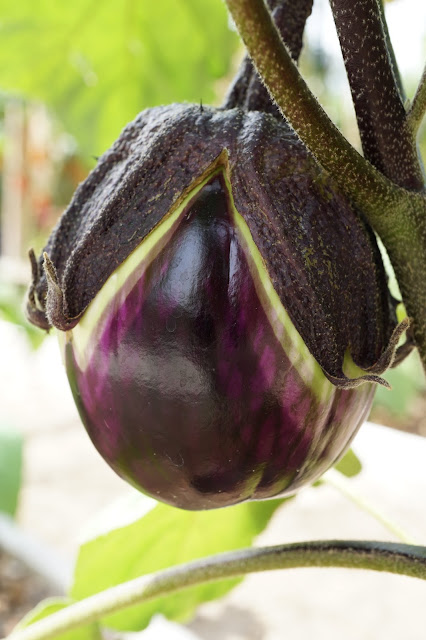The recipe is below, but first let me introduce Prosperosa eggplant, perhaps the prettiest eggplant I've grown.
The contrasting white collars make this eggplant a standout. A closer look reveals the details are an ombre effect that is a delightful combination of shades of purple and pale green. In the bright sunlight, the colors come alive.
As photogenic as they are, I couldn't help myself. I love purple and green together.
Beautiful, rich colors!
The plant is an upright grower with large leaves. Mine is currently approaching 4 feet tall, and it has produced several eggplants that are softball-sized and larger.
We have been enjoying eggplant parmesan but we wanted to make something new, and my husband found this recipe for Pasta alla Norma. It's from Jamie's Italy, by Jamie Oliver (Hachette Books). He adapted it a bit to use what we had on hand. He also left out the onion since I can't eat it. What can I say except this may be my new favorite pasta dish. The way the eggplant is prepared, it combines with the tomatoes to create a creamy sauce. Oh my, it is good!
2 large eggplants, tops removed
9 Tbsp extra-virgin olive oil, divided
salt
6 garlic cloves, peeled and thinly sliced lengthwise
1 small red onion, finely chopped
1/2 tsp red pepper flakes
1 28-oz can plum tomatoes in puree, pureed or hand crushed in the sauce
1 tsp sugar
1 lb spaghetti or other pasta
1 cup torn basil leaves
shavings of Parmesan or Pecorino (we used grated instead of shaved cheese)
Preheat oven to 475 degrees with racks on the upper and lower thirds. Cut each eggplant lengthwise into eighths. Cut out the fluffy cores from the wedges, leaving 1/2 inch thick shells. Cut the shells crosswise into 3/4 inch thick strips. Toss them with 6 Tbsp of olive oil and 1 tsp salt in a bowl. Place them onto 2 oiled rimmed baking sheets and roast in the oven. Stir the eggplant and switch the location of the backing sheets half way through. Cook until tender and browned, total of 20-25 minutes.
While the eggplant is roasting, heat the remaining oil in a heavy skillet over medium heat, saute the garlic, stirring, until golden, then transfer the garlic with a slotted spoon to a small bowl.
Stir onion, red pepper flakes and 1/2 tsp salt into the skillet. Cook, covered, over medium heat, stirring occasionally, until the onion is tender, about 6 min.
Add the tomato puree and sugar, briskly simmer, uncovered, until thickened slightly, 10-15 min.
Cook pasta per the package instructions. Reserving 1 cup of the pasta water, drain the pasta and return pasta to the pot. Add the sauce and the eggplant. Toss for about one minute to cover the pasta and eggplant with the sauce, thinning with the pasta cooking water as necessary. Stir in the garlic and half of the basil.
Serve, and top with the remaining basil and the cheese.
If you happen to have left-overs, it is amazing as a cold pasta salad the next day!











































